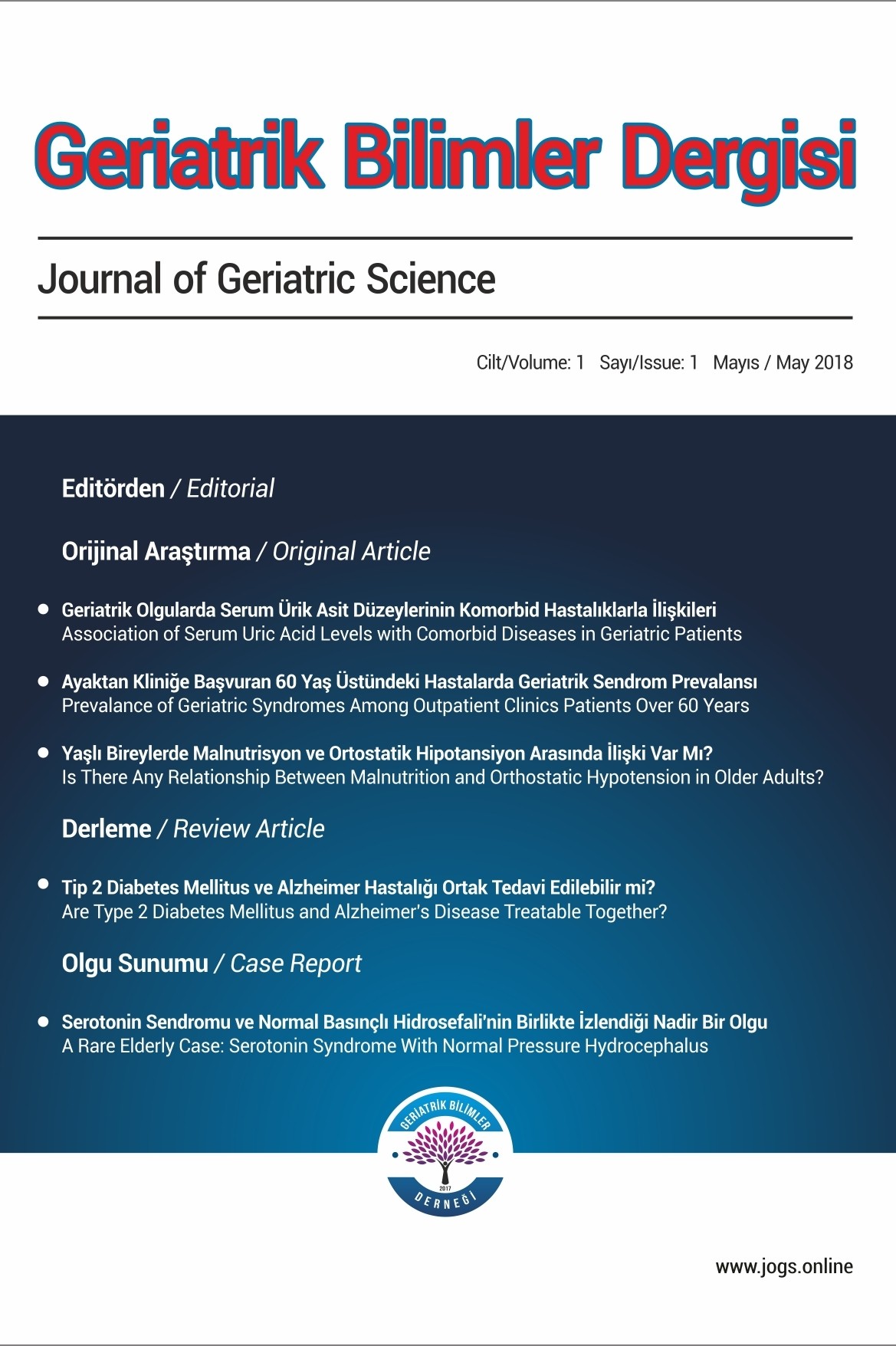Hiperüriseminin Kas Gücü ve Kütlesi Üzerine Etkisi
ürik asit, sarkopeni, kas gücü, kas kütlesi, yaşlı
The Impact of Hyperuricemia on Muscle Strength and Mass
uric acid, sarcopenia, muscle strength, muscle mass, older adults,
___
- 1. Dhillon RJ, Hasni S. Pathogenesis and Management of Sarcopenia. Clin Geriatr Med. 2017;33(1):17-26.
- 2. Ates Bulut E, Soysal P, Aydin AE, et al. Vitamin B12 deficiency might be related to sarcopenia in older adults. Exp Gerontol. 2017;95:136-40.
- 3. Fulle S, Protasi F, Di Tano G, et al. The contribution of reactive oxygen species to sarcopenia and muscle ageing. Exp Gerontol. 2004;39(1):17-24.
- 4. Johnson RJ, Segal MS, Srinivas T, et al. Essential hypertension, progressive renal disease, and uric acid: a pathogenetic link? J Am Soc Nephrol. 2005;16(7):1909-19.
- 5. Choi HK, Ford ES. Prevalence of the metabolic syndrome in individuals with hyperuricemia. Am J Med. 2007;120(5):442-7.
- 6. Cortese F, Giordano P, Scicchitano P, et al. Uric acid: from a biological advantage to a potential danger. A focus on cardiovascular effects. Vascul Pharmacol. 2019;120:106565.
- 7. Feig DI, Kang DH, Johnson RJ. Uric acid and cardiovascular risk. N Engl J Med. 2008;359(17):1811-21.
- 8. Tuven B, Soysal P, Unutmaz G, et al. Uric acid may be protective against cognitive impairment in older adults, but only in those without cardiovascular risk factors. Exp Gerontol. 2017;89:15-9.
- 9. Macchi C, Molino-Lova R, Polcaro P, et al. Higher circulating levels of uric acid are prospectively associated with better muscle function in older persons. Mechanisms of Ageing and Development. 2008;129(9):522-7.
- 10. Huang C, Niu K, Kobayashi Y, et al. An inverted J-shaped association of serum uric acid with muscle strength among Japanese adult men: a cross-sectional study. BMC Musculoskeletal Disorders. 2013;14(1):258.
- 11. Kawamoto R, Ninomiya D, Kasai Y, et al. Serum Uric Acid Is Positively Associated with Handgrip Strength among Japanese Community-Dwelling Elderly Women. PloS one. 2016;11(4):e0151044-e.
- 12. Xu Z-R, Zhang Q, Chen L-F, et al. Characteristics of hyperuricemia in older adults in China and possible associations with sarcopenia. Aging medicine (Milton (N.S.W)). 2018;1(1):23-34.
- 13. American Psychiatric Association. Diagnostic and Statistical Manual of Mental Disorders. 5th ed. Washington, DC, 2013.
- 14. Fried LP, Tangen CM, Walston J, et al. Frailty in older adults: evidence for a phenotype. J Gerontol A Biol Sci Med Sci. 2001;56(3):M146-56.
- 15. Freeman R, Wieling W, Axelrod FB, et al. Consensus statement on the definition of orthostatic hypotension, neurally mediated syncope and the postural tachycardia syndrome. Clin Auton Res. 2011;21(2):69-72.
- 16. Cruz-Jentoft AJ, Bahat G, Bauer J. Sarcopenia: revised European consensus on definition and diagnosis. Age Ageing. 2019;48.
- 17. Ates Bulut E, Soysal P, Dokuzlar O, et al. Validation of population-based cutoffs for low muscle mass and strength in a population of Turkish elderly adults. Aging Clin Exp Res. 2020.
- 18. Unutmaz GD, Soysal P, Tuven B, et al. Costs of medication in older patients: before and after comprehensive geriatric assessment. Clin Interv Aging. 2018;13:607-13.
- 19. Chen-Xu M, Yokose C, Rai SK, et al. Contemporary Prevalence of Gout and Hyperuricemia in the United States and Decadal Trends: The National Health and Nutrition Examination Survey, 2007-2016. Arthritis Rheumatol. 2019;71(6):991-9.
- 20. Cooper R, Kuh D, Hardy R. Objectively measured physical capability levels and mortality: systematic review and meta-analysis. Bmj. 2010;341:c4467.
- 21. Janssen I, Shepard DS, Katzmarzyk PT, et al. The healthcare costs of sarcopenia in the United States. J Am Geriatr Soc. 2004;52(1):80-5.
- 22. Cirillo P, Sato W, Reungjui S, et al. Uric acid, the metabolic syndrome, and renal disease. J Am Soc Nephrol. 2006;17(12 Suppl 3):S165-8.
- 23. Russell ST, Eley H, Tisdale MJ. Role of reactive oxygen species in protein degradation in murine myotubes induced by proteolysis-inducing factor and angiotensin II. Cell Signal. 2007;19(8):1797-806.
- 24. Kutzing MK, Firestein BL. Altered uric acid levels and disease states. J Pharmacol Exp Ther. 2008;324(1):1-7.
- 25. Wu Y, Zhang D, Pang Z, et al. Association of serum uric acid level with muscle strength and cognitive function among Chinese aged 50-74 years. Geriatr Gerontol Int. 2013;13(3):672-7.
- 26. Beavers KM, Beavers DP, Serra MC, et al. Low relative skeletal muscle mass indicative of sarcopenia is associated with elevations in serum uric acid levels: findings from NHANES III. J Nutr Health Aging. 2009;13(3):177-82.
- Yayın Aralığı: Yılda 3 Sayı
- Başlangıç: 2018
- Yayıncı: Geriatrik Bilimler Derneği
Yaşlılarda Serum Homosistein Düzeyi ile Osteoporoz Arasında İlişki Var mı?
Mehmet Selman ÖNTAN, Özge DOKUZLAR
Hiperüriseminin Kas Gücü ve Kütlesi Üzerine Etkisi
Esra ATEŞ BULUT, Suleyman Emre KOCYIGIT, Ali Ekrem AYDIN
Çok Yönlü Geriatrik Değerlendirmede Multidisipliner Ekip Yaklaşımı ve Hemşirenin Rolü
